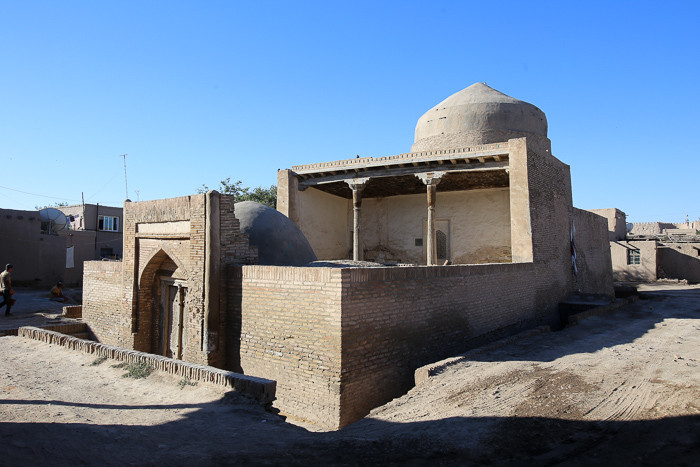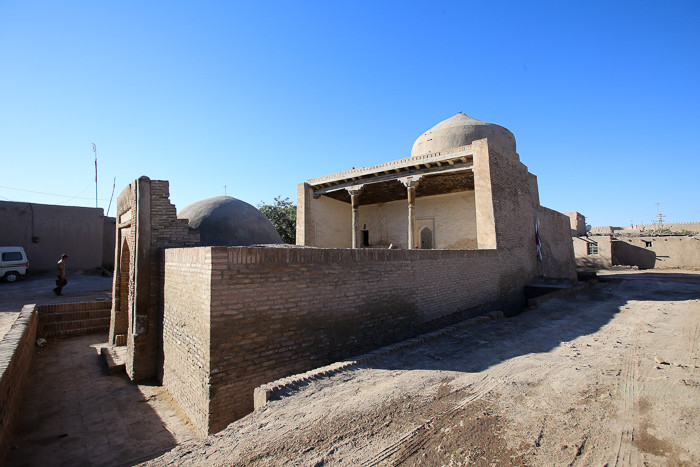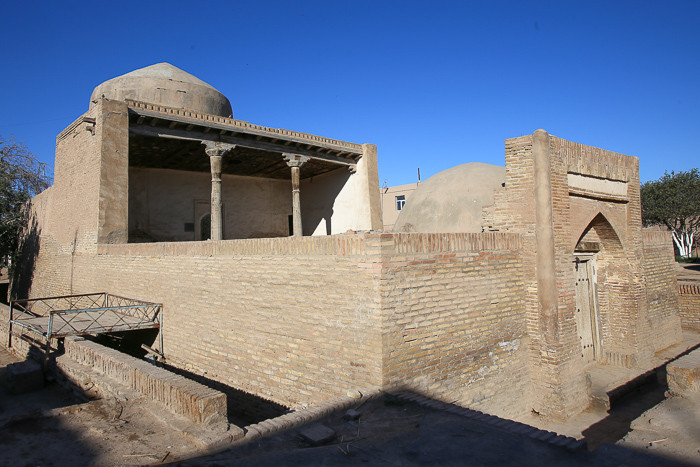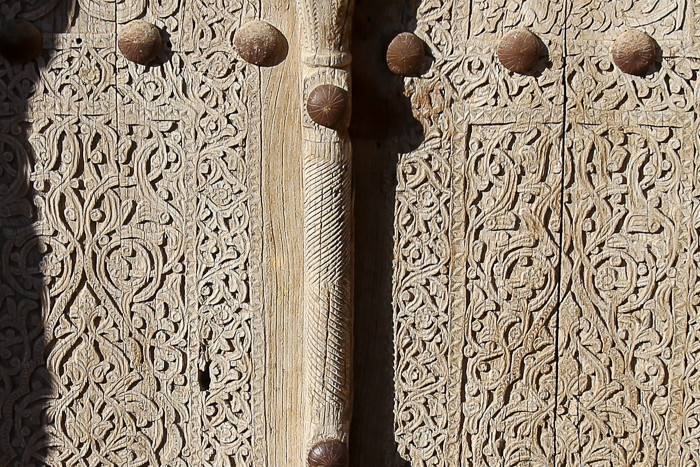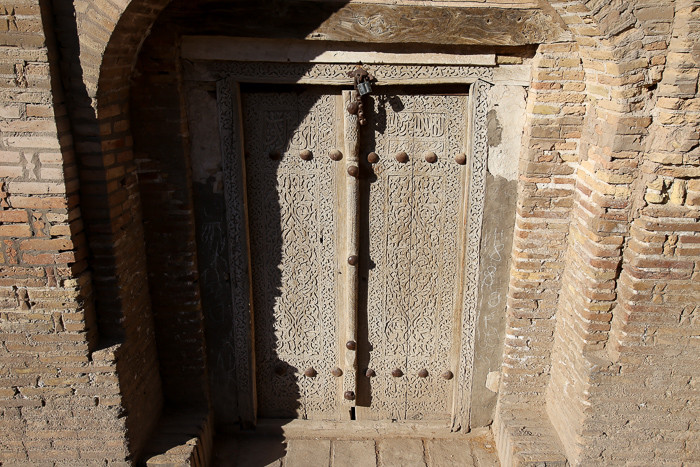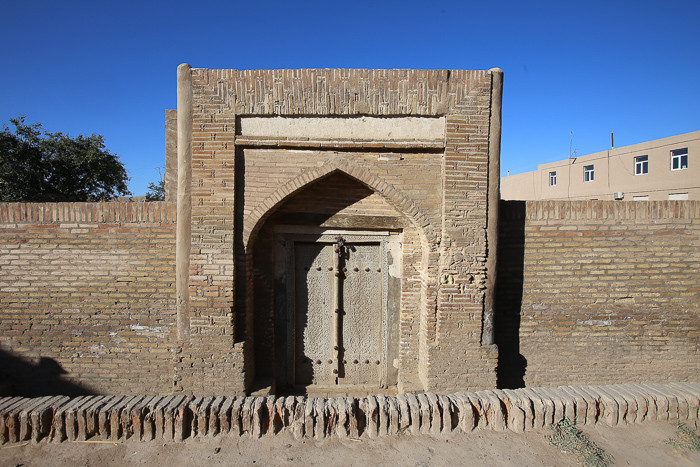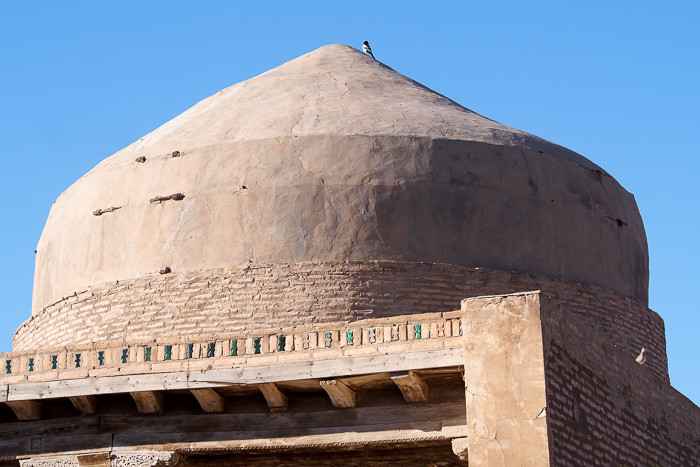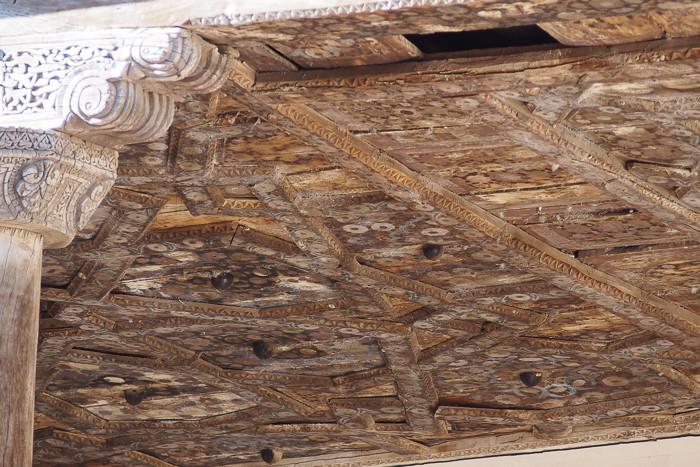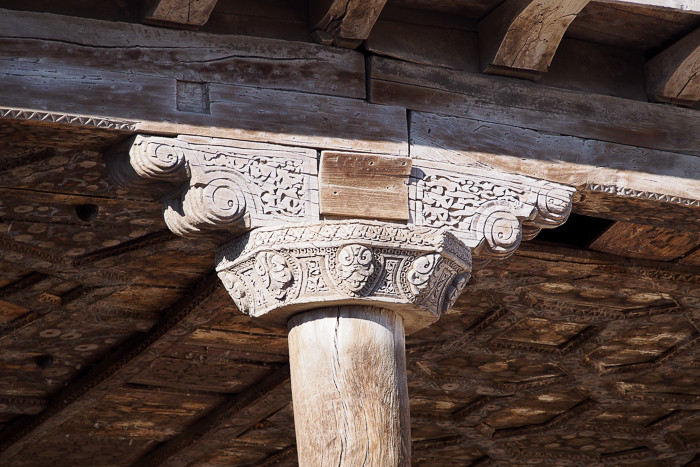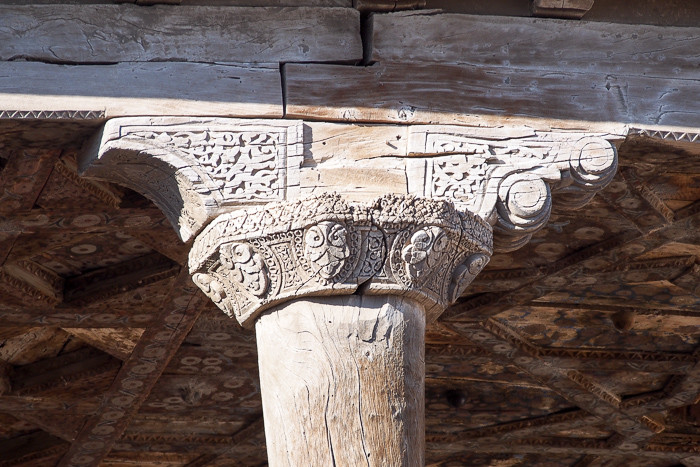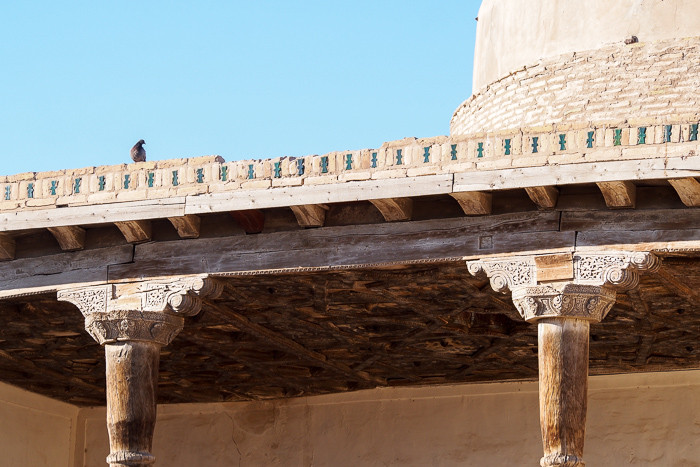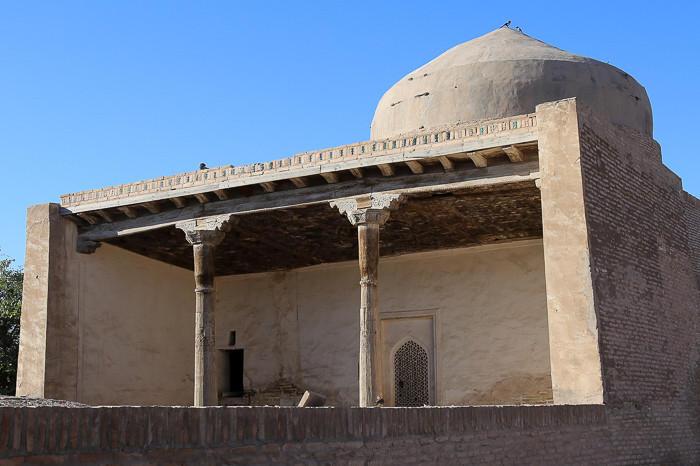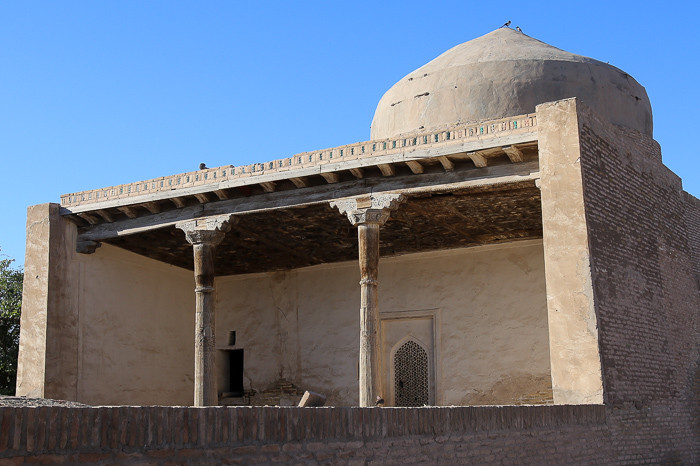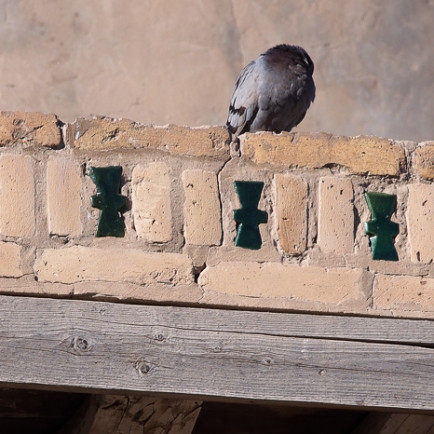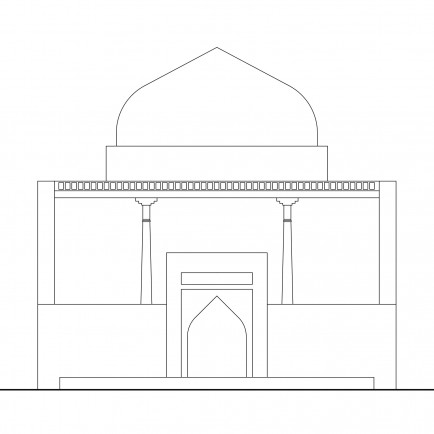Baghbanli Mosque
History
“Another city of Khorezm was called Urgench. It was destroyed by Genghis Khan. When this tyrant arrived, there were twenty cathedral mosques in it, where Friday service was sent; each of them occupied an area of three tanabas. On the four sides of the city were buried in verdure namazgah, in which there were three or four varnishes to the people. Every servant served one thousand servants. The majority of the population of Urgench were descendants of Khazret Ya’kub, peace be upon him! The blessed mazar of Sham'un, his eldest son, is in Mizdahkan, now known as Khoja Eli (Khodjeyli)
Urban and Architectural
the mosque is oriented to the north with a broad iwan in front of the dome—a design feature that provided worshippers with shade throughout the day. Although normally kept locked, visitors may admire the two columns supporting the iwan which were carved in the 15th century and reused in the mosque's 19th-century reconstruction. The capitals of the two columns are vaguely Corinthian in character and incised with foliate motifs. The ceiling of the iwan is also richly decorated with geometric motifs and traces , the decorative elements of this quarter-mosque show the beauty of tradition of the Khorezm school of architecture once more. Unlike the magnificent mosques, the neighborhood houses of worship are of smaller size, but are as striking in their use of space and splendid decorations.
In the neighborhood mosque Bagbanly, built in the southern part of Ichan-kala at the beginning of the nineteenth century, one finds an example of this. The mosque is a building of symmetrical composition, where there is a darvazakhana, yard, aivan and mosque hall on the longitudinal axis north south.
The entrance consists of three parts. There is a cupola-topped building in the center. On the sides of it there are rooms for ritual washing (tokharatkhana). The mosque represents a rectangular hall with a two- pillared aivan opened to the north.
A cupola tops the hall. Coloured overlay and a carved door decorate the facade of the darvazakhana. The interior is plastered. The decorated ceiling of the aivan is covered by patterns. The wooden pillars, apparently, were brought here from another building.
Their decoration, similar to the pillars of the sixteenth century from Jumah mosque suggests this idea. There are many scripts of nastalikh type in the interior of the hall, on the walls of the aivan and on the doors, giving verses, the date of construction - 1809 - and the name of the master, Ruz Muhammad.
The original-figured capitals soften the change of vertical pillar to horizontal beams. On the doors the name of other master is inscripted, the woodcarver – Ruz Muhammad the son of Adin Muhammad who carved the doors leading to the ziyarat-khana (pilgrimage room) of the mausoleum of Sheikh Mukhtar-Valy in the village of Astana of the Yangiarik district.
The legend says that the mosque was built on the money donated by two brothers-gardeners. Mosque rectangular shape, has a two-column columned aivan (terrace) and domed wintertime room.
Carved wooden columns of the aivan (terrace) are of art value and decor of the columns remind the patterns of Juma Mosque.
Description
The Baghbanli Mosque is an often overlooked gem nestled amid the urban fabric in the southeast corner of the Ichan Qala (old city). The composition of the Baghbanli reminds one very much of the Ak-Mechet with only one difference, that the latter has an aivan on three sides. The harmonic combination of the open space with a yard, which has a half-open aivan and closed hall, gives the mosque Baghbanli completeness and steadiness.
References
Chuvin, Pierre and Gerard Degeorge. Samarkand, Bukhara, Khiva. Italy: Flammarion, 2001.
Dani, Ahmad H., et al. History of civilizations of Central Asia. Paris: Unesco, 1992.
Gangler, Anette et. al. Bukhara: the Eastern Dome of Islam. City: Axel Menges, 2004.
MacLeod, Calum, and Bradley Mayhew. Uzbekistan: the Golden Road to Samarkand. Hong Kong & New York: Odyssey Books & Maps. Distributed in the USA by W.W. Norton & Company, Inc, 2014.
Soustel, Jean & Porter, Yves. Tombs of Paradise: The Shah-e Zende in Samarkand and Architectural Ceramics of Central Asia. Hong Kong: Paul Holberton publishing, 2002.
UNESCO. Kiva: City of a Thousand Domes. Paris: Sharq, 1997
Details
Location
Khiva, Uzbekistan, The approximate location of the site is 41.375961' N, 60.359699' E (WGS 84 map datum).
Architect Name
Year of Build
(rebuilt 1809)
Drawings
Map
History
“Another city of Khorezm was called Urgench. It was destroyed by Genghis Khan. When this tyrant arrived, there were twenty cathedral mosques in it, where Friday service was sent; each of them occupied an area of three tanabas. On the four sides of the city were buried in verdure namazgah, in which there were three or four varnishes to the people. Every servant served one thousand servants. The majority of the population of Urgench were descendants of Khazret Ya’kub, peace be upon him! The blessed mazar of Sham'un, his eldest son, is in Mizdahkan, now known as Khoja Eli (Khodjeyli)
Urban and Architectural
the mosque is oriented to the north with a broad iwan in front of the dome—a design feature that provided worshippers with shade throughout the day. Although normally kept locked, visitors may admire the two columns supporting the iwan which were carved in the 15th century and reused in the mosque's 19th-century reconstruction. The capitals of the two columns are vaguely Corinthian in character and incised with foliate motifs. The ceiling of the iwan is also richly decorated with geometric motifs and traces , the decorative elements of this quarter-mosque show the beauty of tradition of the Khorezm school of architecture once more. Unlike the magnificent mosques, the neighborhood houses of worship are of smaller size, but are as striking in their use of space and splendid decorations.
In the neighborhood mosque Bagbanly, built in the southern part of Ichan-kala at the beginning of the nineteenth century, one finds an example of this. The mosque is a building of symmetrical composition, where there is a darvazakhana, yard, aivan and mosque hall on the longitudinal axis north south.
The entrance consists of three parts. There is a cupola-topped building in the center. On the sides of it there are rooms for ritual washing (tokharatkhana). The mosque represents a rectangular hall with a two- pillared aivan opened to the north.
A cupola tops the hall. Coloured overlay and a carved door decorate the facade of the darvazakhana. The interior is plastered. The decorated ceiling of the aivan is covered by patterns. The wooden pillars, apparently, were brought here from another building.
Their decoration, similar to the pillars of the sixteenth century from Jumah mosque suggests this idea. There are many scripts of nastalikh type in the interior of the hall, on the walls of the aivan and on the doors, giving verses, the date of construction - 1809 - and the name of the master, Ruz Muhammad.
The original-figured capitals soften the change of vertical pillar to horizontal beams. On the doors the name of other master is inscripted, the woodcarver – Ruz Muhammad the son of Adin Muhammad who carved the doors leading to the ziyarat-khana (pilgrimage room) of the mausoleum of Sheikh Mukhtar-Valy in the village of Astana of the Yangiarik district.
The legend says that the mosque was built on the money donated by two brothers-gardeners. Mosque rectangular shape, has a two-column columned aivan (terrace) and domed wintertime room.
Carved wooden columns of the aivan (terrace) are of art value and decor of the columns remind the patterns of Juma Mosque.
Description
The Baghbanli Mosque is an often overlooked gem nestled amid the urban fabric in the southeast corner of the Ichan Qala (old city). The composition of the Baghbanli reminds one very much of the Ak-Mechet with only one difference, that the latter has an aivan on three sides. The harmonic combination of the open space with a yard, which has a half-open aivan and closed hall, gives the mosque Baghbanli completeness and steadiness.


